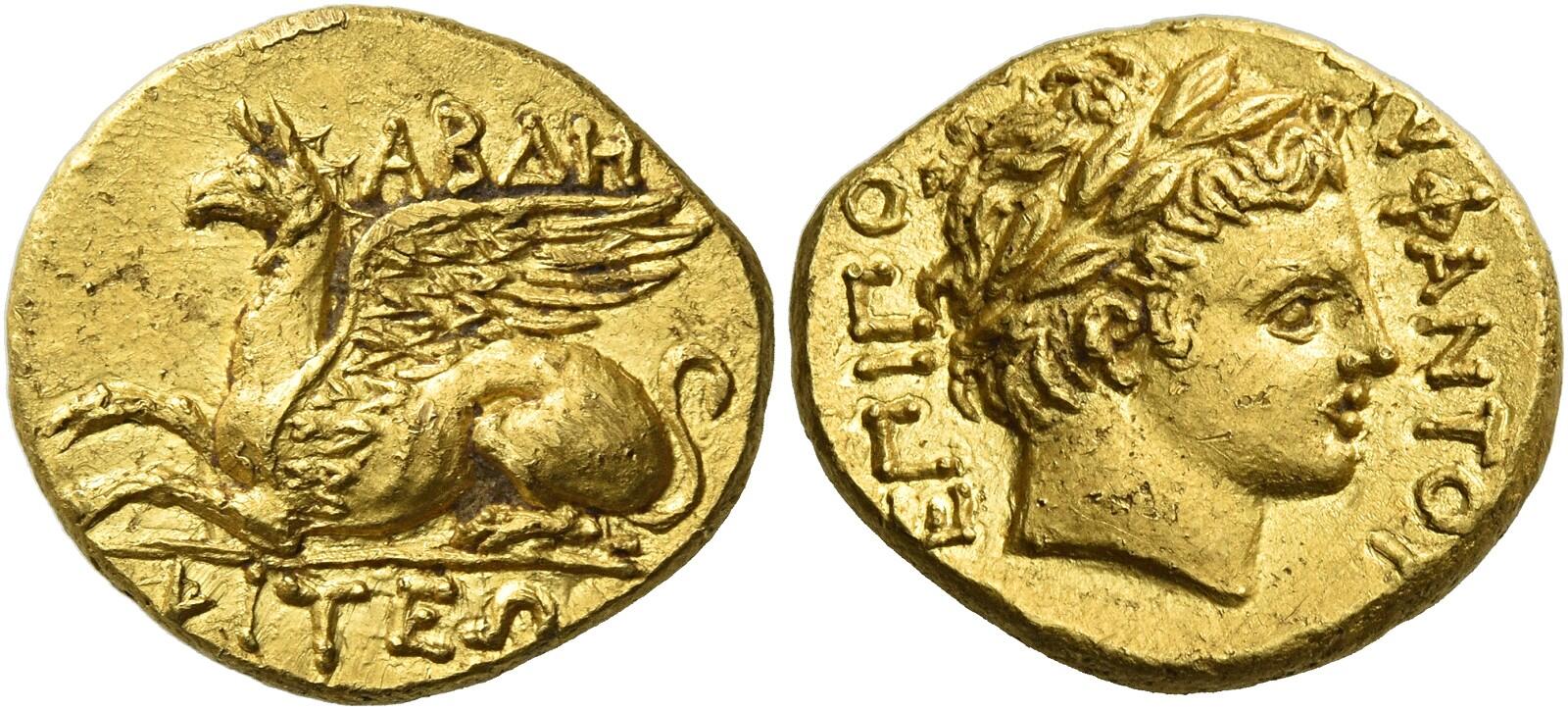Abdera, gold, staters (griffin/Apollo) (346-336 BCE)
346 BCE - 336 BCE Gold 150,592 kg
Description
| ObverseInscription or printing placed on the obverse.: | AB∆H-PITEΩN (Greek).Griffin seated left |
| ReverseInscription or printing placed on the reverse.: | ΕΠΙ ΠΟ−ΛΥΦΑΝΤΟΥ (Greek).Laureate head of Apollo right |
Mint and issuing power
| MintIdentifies the place of manufacture or issue of a numismatic object.: | Abdera | Ancient regionAncient region.: | Macedon | Modern countryModern country: Greece | AuthorityIdentifies the issuing power. The authority can be "pretended" when the name or the portrait of X is on the coin but he/she was not the issuing power. It can also be "uncertain" when there is no mention of X on the coin but he/she was the issuing power according to the historical sources: |
Chronology
| FromIdentifies the initial date in a range assigned in a numismatic context. | 346 BCE | toIdentifies the final date in a range assigned in a numismatic context.. | 336 BCE | PeriodTime period of the numismatic object.: Classical 480-323 BC |
Physical description
| MetalThe physical material (usually metal) from which an object is made.: | Gold |
Median weightMedian of the weights of numismatic objects (in grams). in grams | 6.40 | DenominationTerm indicating the value of a numismatic object. Examples: tetradrachm, chalkous, denarius.: | stater |
StandardStandard.: |
Image

References
| Die study referencePublication of the study: | May 19661May 1966, Group CXXXVII 547-8, Chryssanthaki-Nagle 20072Chryssanthaki-Nagle 2007, p. 155 | ||
| Coin series referenceReference to coin series study: | |||
Obverse dies distribution
| FrequencyFrequency of specimen in distribution. ᵖ | Number of obversesNumber of obverse dies. ᵖ (o) | % (o) | Number of coinsNumber of coins. (n) | % (n) | Die nameName(s) of the die(s). |
| 1 | 2 | 100 | 2 | 100 | 1, 2 |
| Total | 2 of 2 | 100 | 2 of 2 | 100 |
Reverse dies distribution
no distribution is available
Quantification
| Number of obversesNumber of obverse dies. ᵖ (o) | 2 | Number of singletons (o1)The number of singleton coins. ᵖ | 2 |
| Number of reverse diesNumber of reverse dies. (r) | 2 | Number of coinsNumber of coins. (n) | 2 |
| Coins per obverse dieNumber of coins per obverse die. (n/o) | 1 | Coins per reverse dieNumber of coins per reverse die. (n/r) | 1 |
| Reverse per obverse ratioRatio of obverse dies divided by reverse dies. (r/o) | 1 | Percentage of singletons (o1)number of coins (n) divided by the number of singletons (o1) ᵖ | 100 % |
| Original number of dies (O) (Carter 1983 formula)The estimation of the number of coins according to Carter 1983 ᵖ | 117.65 | Coins struck if 20,000 as average productivity per dieCoins made if the average productivity for obverses (according to Carter) is 20,000. ᵖ | 2,353,000 |
| Original number of dies (O) (Esty 2011 formula)The estimation of the number of coins according to the singleton formula in Esty 2011 ᵖ (O) | Survival rate if 20,000 as average productivity per dieSurvival rate if average productivity is 20,000. ᵖ | 0.00000 | |
| Coverage (o = % of O) (Esty 1984 formula)Esty 1984 - coverage (% of O) ᵖ (o = % of O) | 0% | Die productivity if survival rate 1/2,000Average productivity if survival rate is 1/2,000. ᵖ | 34 |
| Weight of silver (in kg) if 20,000 coins per die (O = Carter formula)Carter 1983 * Median weight * 20000 (*10 if gold or electrum) ᵖ | 150,592 kg <br /> 150,592 kg | Die productivity if survival rate 1/5,000Average productivity if survival rate is 1/5,000. ᵖ | 85 |
Remarks
Most likely one single workstation See Roma Numismatics, XI, 7 avr. 2016, lot 264 and Triton II, 1 Dec. 1998, lot 347: "This unique stater, like the unique half stater of May's period VIII, raises many questions. May dated his period VIII from circa 375-360 BC. His explanation for the half stater was that it was an issue of necessity struck after the defeat of Abdera's army and the devastation of its territory by the Triballoi. His period IX covers the approximate dates of 360-345 BC. Since prior to the regular issues of gold by Philip II of Macedon, Greeks striking gold meant economic or military troubles, then one could conclude that this stater was connected with similar contemporary events. However, the context in which it was found has cast doubt on the dating of May's periods. The small hoard contained tetradrachms of Philip II struck posthumously under his son Philip III, as well as Abderan tetradrachms of period IX. None of the coins showed any significant wear. The evidence of this hoard may cause down-dating of the period by as much as forty years."